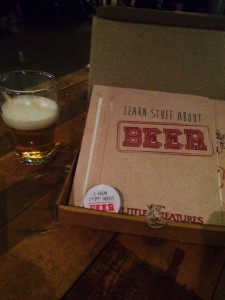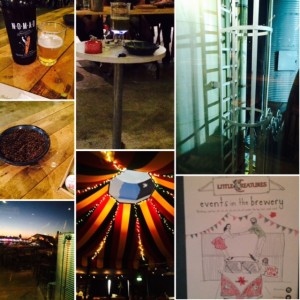Little Creatures Beer School
I’ve been lucky enough to attend lots of consumer wine tastings across England, France and here in Australia. But I’ve never been to a beer school. Whether you call it ‘craft’ beer or interesting ales or you’ve noticed a rise in brewers with bigger and bushier beards, there’s no denying the increase of these beers!
Over the years my palate has developed as I’ve tasted hundreds of wines. With regards to beer, I only started trying different styles over 18 months ago. So when my friend told me about this class, I couldn’t wait to go along! Last night was pretty busy, there were 25 of us including ‘Team Bryn’ (see ‘Paddling to Rottnest’ post). The class started with Wes, who looks after the sales and marketing, talking about the key ingredients of beer; water, barley, hops and yeast.
Wes told us all that as water makes up a huge majority (94%) it really highlights the importance of good water! Going back to basics, water leeches minerals from earth and if water has a high level of mineral content, then the water is hard. If it’s low mineral content, then it’s soft water. Look at Guiness as an example, dark and heavy right? So there’s it’s minerals galore in here!
At wine tastings, I’ve been used to spitting but Wes said we have to drink the beer to taste the bitterness which is what we detect at the back of our palate (we taste salt and sweet at front of palate). So I was glad I took a taxi!
Wes went on to talk about malted grains, malting and a malster. Little Creatures buys malts from the UK and over east. He discussed roasting malts and the different styles For example, if they are darker, then they’ve been in the oven for a longer time and the starch has been roasted off. Mixing malts is an option too. Malts add flavour and add sweetness.
Then we learnt about hops which are flowers and grow in cooler conditions. It was the monks who found that by adding hops to beer that it meant the beer wouldn’t go off, as it had before. So it saved so much time; the beer would last longer and could be stored and therefore brewers didn’t have to be spending all day every day making beer and could instead get on with growing their cro[s to ensure they could feed their families! We also learnt that the hops round the beer and keep it balanced. There are hop flowers and hop pellets and hop extract. As hops are perishable, they are more expensive than malts. It’s interesting to learn that WA does not yet create commercially available hops. For Little Creatures Pale ale, they use lots of different hops as they can’t get 100% hops from one company. Pale Ale was the biggest selling tap beer last year in WA because of this; you can add lots of flavours to the ale.
Yeast is the final ingredient which produced the alcohol and esthers and vinyls which are the flavours. We learnt that yeast used for larger can ferment at 14-16 degrees (creating a clean and crisp beer which lacks flavour). For ales, yeast can ferment at a higher temperature and quicker than larger beer yeast. And I think that yeast is the magic ingredient because no one knows what strain of yeast is used at Little Creatures. You go to a winery here in WA and you ask what strain of yeast do you use and they can tell you if it’s not wild yeast. But at Little Creatures, this is top secret, only one place knows the strain they use and that’s stored in Copenhagen.
We also talked about containers/packing for beers….I’ve seen an increasing amount of cans used for beers. Back in the day, I found the standard every day drinking beer was put into a can but today you’ll see Pirate Life and Colonial using cans and with good reason. As Wes explained; sunlight and light in general actually damages beer so with a can you eradicate this option. Also cans are less likely to oxidise and will stay fresh for longer and are more environmentally friendly. Cans get my vote!
I felt I was back at a chemistry lab at school because Wes set up a mini brewing station in front of us all where he took us through and showed us the milling process, mashing, then the lautering. In reality lautering takes 2 hours and the by product feeds cattle; I like it, it’s recycling. So this is the longest process of brewing. But for tonight, we didn’t wait the 2 hours. Then it’s brewed to 100 degrees but under pressure you can boil up to 105. The process called whirlpool is next where all the particles from the liquid are removed followed by hop back which extracts the hop flavours into the beer. Then they reduce the temperature and finally add yeast.
Wes didn’t show us the bottling process for obvious reasons but it was interesting to learn that the bottling process is the most expensive part of making beer. And as we in Australia like a slight spritz on our beers, this is added at this point.
What an informative evening! I can wear my beer badge (titled ‘I know stuff about Beer’) with pride now!
We tried the below beers:
Pilsner (Czech Republic): We started with a Pilsner which he described as a ‘clean and crisp larger.’ Clean and clear and from the Czech republich. Tasty and refreshing I found!
Founders Porter (USA): Then we tried this beer which was made of heavily roasted malts. I thought it tasted of coffee and dark chocolate. Tasty but I couldn’t drink too much!
Sierra Nevada Torpedo Extra IPA (USA): This is an IPA which stands for Indian Pale Ale and I learnt this was invented in the UK for soldiers fighting in India. It was during this time that dry hopping came about. By adding these to the beers on the ship, it meant it avoided it going off.
Little Creatures Rogers (WA): This is a medium dark beer with a lower abv at 3.8% created used less malts and leaves more residual sugar. The beer was named after Roger Bailey and Roger Bussel who helped build Little Creatures. I like the style, refreshing with a touch of toffee flavours and not too overpowering.
Nomad Freshie Salt & Pepper (NSW): The last beer I found was a bit perfumed. Different, light and interesting aromas on nose and palate. Good way to end the night. Apparently they add sea water and Tasmanian pepper to the beer, pretty cool.
Then a few bowls of French fries with aioli sauce came along….delicious! I’ll go running tomorrow to work off all those calories……
Thanks Little Creatures!
And to top it all off, the event was completely free! It’s refreshing to go to a free event in Perth and spend a fun evening with friends.


